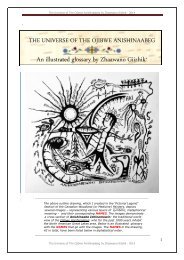The Universe Of The Ojibwe Anishinaabeg, an illustrated glossary by Zhaawano Giizhik*
A Glossary written and illustrated by Native Woodland artist Zhaawano Giizhik demonstrating a cross section of Anishinaabe Izhinamowin: the traditional worldview of the Ojibwe Anishinaabeg, who for the past 2 millennia inhabit the North American Great Lakes area.
A Glossary written and illustrated by Native Woodland artist Zhaawano Giizhik demonstrating a cross section of Anishinaabe Izhinamowin: the traditional worldview of the Ojibwe Anishinaabeg, who for the past 2 millennia inhabit the North American Great Lakes area.
Create successful ePaper yourself
Turn your PDF publications into a flip-book with our unique Google optimized e-Paper software.
<strong>The</strong> <strong>Universe</strong> of <strong>The</strong> <strong>Ojibwe</strong> <strong>Anishinaabeg</strong> <strong>by</strong> Zhaaw<strong>an</strong>o Giizhik - 2014<br />
Traditionally, the <strong>Anishinaabeg</strong> approach life in a sacred m<strong>an</strong>ner. When taking a<br />
mashkiki (pl<strong>an</strong>t), ojiibik (root), or mashkosiw (herb), one always explains to its spirit<br />
why it is being done, <strong>an</strong>d offers some asemaa (tobacco) in return. While putting asemaa<br />
in the hole one would respectfully tell the spirit of the dug-up pl<strong>an</strong>t or root that GICHI-<br />
MANIDOO allowed it to grow in that certain spot for the benefit of m<strong>an</strong>kind <strong>an</strong>d that the<br />
tobacco is been given in return so that the pl<strong>an</strong>t will do it’s best to make the medicine<br />
work. This is the way it has always been done <strong>an</strong>d always will be done.<br />
Using a feather to f<strong>an</strong> the smoke of a nookwezig<strong>an</strong>, or smudge stick resting in a shell that is used as a bowl.<br />
To the Mideg, those who practice the medicinal ways of the Midewiwin, <strong>an</strong>d all the others<br />
who follow Anishinaabe-bimaadiziwin, the Traditional Road, there are four pl<strong>an</strong>ts that are<br />
especially revered while used in daily living. <strong>The</strong>se pl<strong>an</strong>ts are:<br />
<br />
<br />
<br />
<br />
ASEMAA, tobacco, representing the Eastern direction. <strong>The</strong> oldtime <strong>Anishinaabeg</strong><br />
also used giniginige (commonly written as “kinnikinnick”), a mixture of<br />
mishkoobimizh (red osier dogwood) with zaagaakominaga<strong>an</strong>zh (bearberry) <strong>an</strong>d<br />
tobacco, or sometimes mishkwaabiimizh (red willow) with wiingashk (sweetgrass).<br />
Both asemaa <strong>an</strong>d giniginige are still used in the offering of prayer to GICHI-<br />
MANIDOO, as a way of communication, their smoke lifting the prayers to the<br />
Great Mystery, or set on the ground in a cle<strong>an</strong> place as <strong>an</strong> offering. Either offered<br />
through the fire (Zagaswaawin, smoking of tobacco) or just held in h<strong>an</strong>d, using<br />
tobacco to extend prayers of th<strong>an</strong>kfulness is something that is done on a daily<br />
basis as each new day is greeted. And to this day, Asemaakewin (tobacco<br />
offering) is customary when seeking knowledge or advice from <strong>an</strong> Elder or when a<br />
Pipe <strong>an</strong>d/or a Drum is present.<br />
GIIZHIK, white cedar, representing the Southern direction. When burned, its<br />
snipped leaves act as a purifier, giving out a pleas<strong>an</strong>t piny scent, cle<strong>an</strong>sing the<br />
area as well as body <strong>an</strong>d soul of <strong>an</strong>y particip<strong>an</strong>t.<br />
MASHKODEWASHK, white sage, representing the Western direction. It is burned<br />
as a purifier, emitting a spicy scent.<br />
WIINGASHK, sweetgrass, representing the North. This too, is a purifier,<br />
replacing negative with positive. It gives out a sweet, aromatic scent, especially<br />
when burnt or when it rains. When it is harvested, it is cut, never pulled. M<strong>an</strong>y<br />
things are made with it such as wiingashkoo`iin<strong>an</strong> (coiled baskets), <strong>an</strong>d when<br />
braided it signifies the hair of Omizakamigokwe (Ogashin<strong>an</strong>), the Earthmother.<br />
According to Midewiwin tradition, a long time ago the <strong>Anishinaabeg</strong> mysteriously lost the<br />
gift of health <strong>an</strong>d long life, <strong>an</strong>d they fell prey to a terrible epidemic in droves. One of the<br />
<strong>The</strong> <strong>Universe</strong> of <strong>The</strong> <strong>Ojibwe</strong> <strong>Anishinaabeg</strong> <strong>by</strong> Zhaaw<strong>an</strong>o Giizhik - 2014<br />
84





